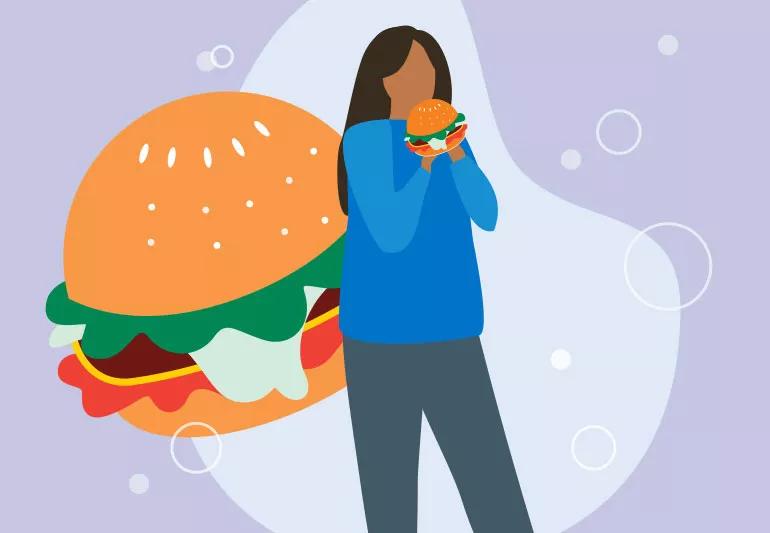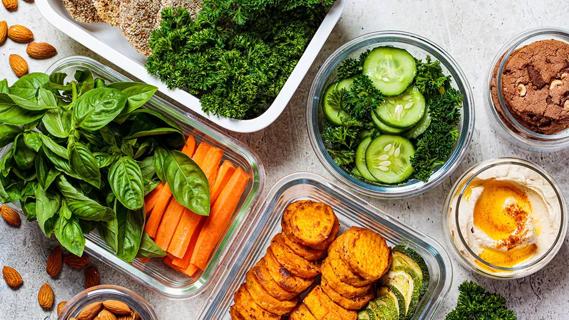Large portions, restrictive diets, emotions and social cues can all play a role in overeating

You probably know the feeling: You weren’t full yet, so you kept eating, and now you’re uncomfortably overstuffed. Why, oh, why didn’t you set down that sandwich (or salad or pasta or whatever) just a liiiittle bit sooner?!
Advertisement
Cleveland Clinic is a non-profit academic medical center. Advertising on our site helps support our mission. We do not endorse non-Cleveland Clinic products or services. Policy
It can be surprisingly difficult to tell when you’re full — and it can leave you feeling frustrated with your ability to know your own body and control your eating habits, says psychologist Susan Albers, PsyD.
“Fullness confusion is one of the biggest mysteries and difficulties that people tell me they face,” she says. “They say, ‘I never feel full,’ or ‘I go from feeling starved to being overly full without intending to.’ It’s a frustrating and exhausting repeated cycle.”
So, how can you change your ways? Dr. Albers explains why so many people have such a hard time with fullness and how you can better tune into the signals your body sends you about when you’ve had enough to eat.
Have you ever heard that it can take up to 30 minutes after eating to recognize that you’re full? It’s true, Dr. Albers says. There’s a lag time between eating enough to become full and your brain realizing that you feel full — and it’s during that in-between time that you may continue eating and end up feeling stuffed.
“There’s a huge gap between being physically satisfied and realizing in your mind that you’re full,” she continues. “The connection between them is more like old-school dialup speed than instantaneous WiFi.” (She adds that she considers “being full” to mean being satisfied or not hungry anymore, rather than your stomach being filled to the brim.)
Advertisement
But what actually happens between taking a bite and feeling full? It’s a complex process that scientists don’t yet completely understand. But it goes something like this:
“Basically, it takes a while for all your hormones and insulin levels to rise enough for the brain to detect them,” she explains. “It’s not a super speedy process.”
And as it turns out, chemistry is only half the picture.
Emotions and social cues play a role in this process, too. “Fullness is only partly a physical process,” Dr. Albers says.
If, for example, you eat a meal you don’t particularly like, your disappointment can leave you wanting more. On the other hand, if you’re having dinner with a friend who pushes their plate away and declares that they’re full, you might start to feel full, too.
And then, of course, there’s stress eating, mindless snacking and other unintentional but very real eating habits that cause you to overeat, often beyond the point of fullness.
Hunger and fullness are important biological cues that tell you what your body needs — vitamins, nutrients, energy, sustenance and so on. These cues are an integral part of our human DNA, but many of us have learned to suppress and ignore them.
“The biological cues of hunger and fullness aren’t the enemy, as diet culture would like us to believe,” Dr. Albers says. “They are helpful survival tools that allow us to thrive and function well.”
Both hunger and fullness are messages about what you need. But how can you learn to hear and receive those messages? Dr. Albers shares tips for knowing when you’re full, which is closely tied to knowing how hungry you are.
Mindful eating is the antidote to your body’s confusion about hunger and fullness. But what is mindful eating?
“Eating mindfully is about knowing your body,” Dr. Albers says. “There is such a fine line between eating enough to feel satisfied and being overly full. Paying attention as you eat can give you a heads up that you are approaching that line.”
Advertisement
Mindful eating is related to the overall concept of mindfulness, which encourages you to slow down, live in the moment and be in tune with what’s happening around you and inside you. When you eat mindfully, you give careful thought to what you eat and when and why — tuning in to what your body really needs (and what it really doesn’t). A similar concept is called intuitive eating.
“Listen to your body,” Dr. Albers encourages. “Tune in. Let go of diet mantras and diet culture.”
To start, Dr. Albers suggests rethinking the word “full” and replacing it with the word “satiated.” They may seem like similar concepts, but the difference between them makes, well, all the difference.
“When we think about the word ‘full,’ it’s often like filling up a cup or occupying every inch of a space,” Dr. Albers says. “But the fullness that we can feel and perceive in our stomachs is often being overly full. ‘Satiated’ is different, though. Satiated is meeting a need.”
Put the word “full” to the side for a moment. As you eat, don’t ask yourself if you’re full; instead, ask yourself if you’re not hungry anymore. Your goal should be to eat until you’re no longer hungry, not to eat until you’re full. “This is a much different mindset,” Dr. Albers states.
Advertisement
How often do you really take the time to feel your hunger and satiety, or even think about them at all? “Hunger is like a knee-jerk reaction,” Dr. Albers says. “Most of us don’t even slow down for a moment to evaluate the nature of it.”
But eating slowly is the key to getting your stomach, gut and brain in sync. Dr. Albers recommends trying the PAUSE exercise, an acronym that can help you understand how you’re feeling so you can make the right decisions for your body’s needs in any given moment.
Evaluating your hunger — before you eat, while you’re eating and once you’re done — can help you know how much to eat and when you’re full. And there’s more to it than you might realize.
“People think hunger and fullness are only felt in the stomach,” Dr. Albers says. “But in fact, hunger can be related to fatigue, difficulty focusing, irritability, anxiety, headaches, shakiness, dizziness and more. On the other hand, feeling focused, calm, able to concentrate and energized can be a sign of fullness.”
Advertisement
A hunger/satiety scale can help you pause and figure out how hungry, satiated or full you are. Aim to remain with a 4 to 7 on this scale:
| Number | Description of Hunger or Satiety |
|---|---|
| 10 | Absolutely stuffed; uncomfortable to the point of pain and nausea. |
| 9 | Almost completely stuffed; bloated and uncomfortable. |
| 8 | Overly full, feeling some discomfort. |
| 7 | Full but satisfied, with no discomfort. |
| 6 | Satisfied but could eat a little more without discomfort. |
| 5 | Neutral (like in between meals) or beginning to feel hungry. |
| 4 | Grumbling stomach, ready to eat. |
| 3 | Very hungry to the point of irritability (aka “hangry”). |
| 2 | Extremely hungry with low energy and weakness/dizziness. |
| 1 | Starving to the point of feeling unwell; no energy. |
| Number | |
| 10 | |
| Description of Hunger or Satiety | |
| Absolutely stuffed; uncomfortable to the point of pain and nausea. | |
| 9 | |
| Description of Hunger or Satiety | |
| Almost completely stuffed; bloated and uncomfortable. | |
| 8 | |
| Description of Hunger or Satiety | |
| Overly full, feeling some discomfort. | |
| 7 | |
| Description of Hunger or Satiety | |
| Full but satisfied, with no discomfort. | |
| 6 | |
| Description of Hunger or Satiety | |
| Satisfied but could eat a little more without discomfort. | |
| 5 | |
| Description of Hunger or Satiety | |
| Neutral (like in between meals) or beginning to feel hungry. | |
| 4 | |
| Description of Hunger or Satiety | |
| Grumbling stomach, ready to eat. | |
| 3 | |
| Description of Hunger or Satiety | |
| Very hungry to the point of irritability (aka “hangry”). | |
| 2 | |
| Description of Hunger or Satiety | |
| Extremely hungry with low energy and weakness/dizziness. | |
| 1 | |
| Description of Hunger or Satiety | |
| Starving to the point of feeling unwell; no energy. |
“Check in with your body to see where you fall on the scale, ranging from starving to overly stuffed,” Dr. Albers advises. “When you identify your level of hunger before you start eating, this points you to the right intervention.”
How much food does it take for you to actually become full? Large portion sizes, especially in the United States, have skewed our ability to tell — but you can reclaim your understanding.
“Huge portions are one of the No. 1 saboteurs of mindful eating,” Dr. Albers says. “If you’re eating based on external cues, like when the plate is empty, a large portion can trick your brain into thinking, ‘This is how much I should eat,’ versus listening to your internal cues.”
Test out your beliefs about what you think will make you feel full. Experiment with different amounts of food and practice eating slowly. You can even try eating with your non-dominant hand, which can shift you out of autopilot.
Your body and brain love consistency. Even if you don’t realize it, they have the ability to start gearing up for things that happen on a routine basis — including digesting and processing food. But only if you establish a routine eating schedule.
“If you eat at the same time and roughly the same amount each day, your body will begin to anticipate and look forward to eating,” Dr. Albers notes. It will also begin to send clearer signals about fullness and hunger that will become easier for you to recognize.
See what works for you: meal-prepping, setting alarms, writing out reminders, etc. Different strategies work for different people, so experiment with what it takes for you to create and stick to a routine that works for your lifestyle.
Ever scarfed a whole bunch of potato chips and still felt famished? You’re not imagining it. Some foods make you feel fuller than others — and other foods can be eaten in enormous quantities without ever filling you up at all.
“Often, we eat large amounts of food that don’t keep us feeling full, which is why you can eat something and instantly feel hungry again,” Dr. Albers explains. “But some foods are like magic in that they keep you feeling fuller for longer.”
Look for foods that are high in fiber, full of protein and filled with water. Some good options are:
Dr. Albers suggests keeping a list of foods you like that both keep you feeling satisfied and prevent you from getting hungry quickly.
A lifetime of ignoring your body’s hunger and fullness cues can lead to unhealthy relationships with food. “When you feel deprived or are restricting what you eat through dieting, it can be difficult to ever feel full,” Dr. Albers says.
And you don’t have to have an eating disorder (anorexia, bulimia or binge-eating disorder) to have disordered eating behaviors.
“Maybe you’ve been ignoring your hunger or responding to it in inconsistent ways,” Dr. Albers says, “or maybe you struggle with thoughts about shame and guilt when you eat that wreak havoc on your hunger and fullness cues.”
If you can’t seem to get a handle on your hunger and fullness on your own, seek out the help of a professional who can guide you, like a dietitian or a therapist who specializes in eating disorders and other disordered eating behaviors. They can help you get in touch with your biological cues and identify any underlying issues that you haven’t realized on your own.
“Knowing and trusting your body is key,” Dr. Albers continues. “You can stop at what feels like a reasonable amount and trust that when you walk away from the table, you will not be hungry later.”
To learn more on this topic from Dr. Albers, listen to the Health Essentials Podcast episodes, “Understanding Intuitive Eating” and “Eating Disorders: What You Need To Know.” New episodes of the Health Essentials Podcast publish every Wednesday.
Learn more about our editorial process.
Advertisement

With a focus on internal cues for hunger and fullness, this eating style may revolutionize your relationship with food

Review the ingredients, watch for sugar and fat, and choose one with the right amount of protein for your needs

A typical recommended balanced diet is half fruits and veggies, a quarter protein and a quarter grains

Foods high in protein, fiber and water can help keep hunger at bay

This quirky food trend is harmless, as long as you’re getting enough protein, fiber and healthy fats

This vital nutrient helps your brain and body in many ways — and most of us need more of it

Wrapped or sandwiched, try to choose fillings and condiments that are minimally processed, low in saturated fat and high in fiber

Set yourself up for success by carefully choosing your recipes, storage containers and prepping day

Babies can get congested easily, but you can calm their cough by keeping them hydrated, using nasal drops and running a humidifier

Weight loss may cause loose, sagging skin and muscle loss to your rear

Several conditions, like vitiligo and fungal infection, can cause a loss of pigmentation, leading to white spots or patches on your skin